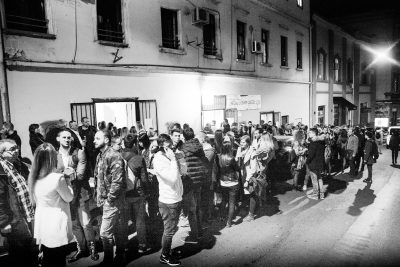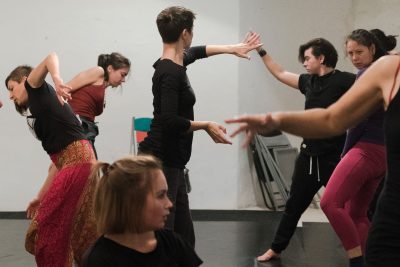Magacin is one of the first-ever grantees of our pilot project FundAction. Magacin is a self-organized common space that operates outside the mainstream public or commercial sectors, accommodates communities and holds great social and cultural value in the city. We spoke to them about their experience and the value of systemic change.
The Magacin space after renovation.
Tell us about the initial idea behind Magacin and how it has developed since then. Where did you find your inspiration and are there any particular examples you followed?
Magacin started off as an idea to provide a working space for the independent cultural scene (druga scena) in Belgrade, since there was nothing available. At the time, in 2007, there was also political will from the City of Belgrade to create a model where the City would take all the (legal) obligations of technically running the space (utilities, cleaning etc.) and independent organisations, selected through an open call, would provide the programme for this unique cultural centre.
This endeavour ended up being a semi-failed attempt in which the youth cultural centre – a City-run institution – managed Magacin. The organisations never got to sign a contract for the use of Magacin, even though they were chosen in the initial call and stayed in the space for a number of years. The situation today hasn’t changed legally for the people using Magacin, but the way the space functions today is much closer to the initial idea of an open, inclusive platform that fosters the values of self-organisation and solidarity.
This became possible for several reasons, one being the threat of eviction by the City, in 2015, when the Association ICSS (Independent Cultural Scene of Serbia) was invited to help in the negotiations. At the time, the open calendar model was proposed, as a way to enable any and all organisations to use the space. After a public debate process it was implemented in practice, since the legal situation is still not resolved.
The model itself was adapted from the model of Pogon cultural centre in Zagreb, which is a public-civil partnership institution. However, in the years since, the model has been developed and adapted to the specific situation of Magacin. Most importantly, since the model was implemented, the number of users and usages has steadily grown, and Magacin is now being used by over 100 different organisations and informal groups with almost ten different calendar entries on a daily basis in seven different spaces.
What are the main obstacles (internal & external) you have encountered while building and running the space?
The main obstacle is the lack of a framework that would support the non-institutional models already at work. This framework could easily be implemented. The “only” issue is the stance the City has towards Magacin. The range goes from ignoring what is now one of the most vibrant cultural centres in Belgrade to trying to evict us. Since the first eviction attempt, which was defended by the big public reaction and a campaign organised by ICSS and implemented by a multitude of users, there was another attempt in late 2016.
The public response to these attempts has been overwhelming and the cultural scene stood by Magacin, which led to the public statement by the City that they will not evict us, but would start a negotiation process. The process is now on hold, as we wait for the first meeting with the new City Secretary for Culture.
Internally, there have been surprisingly few issues, for such a diverse and large group that is self-organised and self-governed. This could possibly be ascribed to the outside threat and the successful action that created more solidarity and readiness to be benevolent and cooperative within the group of users.
Your space is a meeting ground for many diverse organisations and creates encounters for the local community. How can their creative potential influence the cultural policy of the country?
We are not officially recognised as policy makers or stakeholders in that process and our footprint and activities are mainly ignored by the state and city officials and decision makers. Nevertheless, we are trying to be that one elephant that is way too big to be hidden under the carpet. By offering directly available space and facilities, without this usual playing-hard-to-get façade, that is seen as a trademark of any institution in this region, we are trying to undermine some age-old dogmas and thus indirectly bring new cultural policies to the table.
Furthermore, being easily available, we are directly becoming an incubator and a meeting point for many emerging initiatives that are directly affecting cultural policies in their fields.
You want to create a new type of institution based on civic-public partnership, reusing urban space for community purposes. Can you tell us a bit more about your idea and goal, and also your strategy to achieve this? Are you at all afraid to speed up the gentrification process?
The most recent development of Magacin cultural centre happened in some sort of post-apocalyptic cultural environment that emerged after galloping gentrification stormed the area. So for us, it is pointless to be afraid that we might speed it up, as we are rather trying to preserve what can be saved in the aftermath of gentrification.
All the local community bonds that we are building at the moment happened organically as we were not obliged or motivated to produce them at any project or policy level.
In the end, Magacin brought several improvements to the neighbourhood and local community, with some of them even being further reaching. But paradoxically the success of these improvements can be attributed to this non-evangelising, passive approach we established that is usually lacking in the many projects that are aggressively bringing participatory cultural programmes to communities.
How do you work towards systemic change, what is the change you want to see, and how are you planning to achieve it?
The most important and urgent systemic changes are even more commonly available resources and accountability for actions. It is our belief that Magacin is contributing on both of these fronts, since there are so many groups and individuals using the space and it is also available to more and more users each month. The open calendar model is evolving with new types of usage and formats and our goal is to offer the model as a tool that could be used by others in similar or different situations where you need to manage resources that are openly shared by many.
We are continually reflecting on both the day-to-day issues and the overall strategic positioning of Magacin so as to use the fluidity as an instrument to broaden the freedom of this model instead of making it more rigid, which we hope will help to keep the structure running. In the future, we believe it is necessary to push the conversation from one particular space with one activity’s focus to the idea that all public spaces should be publicly available and accountable to the public.






